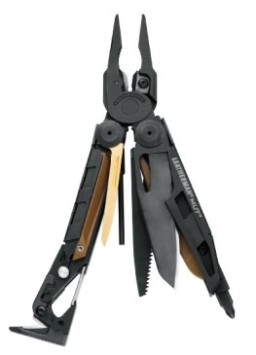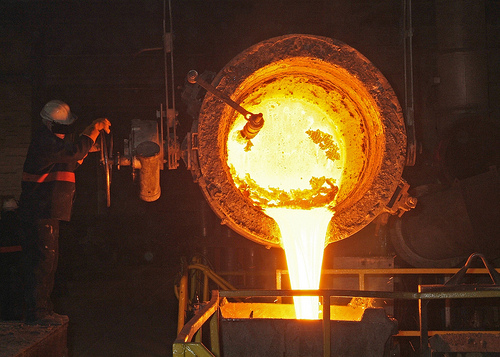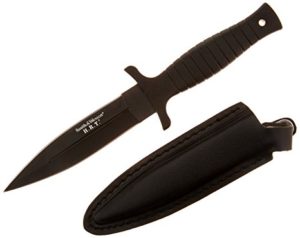420HC Stainless Steel vs. 440C Stainless Steel for Knife Blades
Stainless steel is a preferred material for knife blades because not only does it withstand corrosion, but stainless steel also is easy to keep clean. Stainless steel comes in levels, and the 400 series is believed to be one of the top choices for knife makers since this level is quite resistant to deterioration, as well as being easier to keep the knife blade sharp. As part of the 400 series, the 420HC Stainless Steel and the 440C Stainless Steel are considered two of the top grades in the 400 series for knife blades. Most of the multi-tool reviews you’ll see on this site feature blades made from one of these two steel types. Below is information on the 420HC Stainless Steel and the 440C Stainless Steel.
What is 420HC Stainless Steel?
420HC stainless steel holds a higher carbon intake than the 420. The “HC” in 420HC stands for “high carbon,” and can be brought to a greater hardness than the 420. Because it can be sharpened to a very precise cutting edge and doesn’t rust easily, 420HC stainless steel is the preferred grade in the commercial knife making industry for cutlery, scissors, surgical tools, and knife blades.
Unlike other grades in the 400 series, the 420HC stainless steel knife blades provide extra strength, hardness, and wear resistance than other stainless steel grades. It makes a great knife blade for a general purpose knife due to its ability to resist corrosion and its edge holding capabilities.

 420HC stainless steel knife blades will work for you depending on what you will be using the knife for. Typically, buck knives are mostly made with 420HC stainless steel knife blades. Although it is one of the better grades in the 400 series, it is not considered that durable since the carbon amount is low. Furthermore, this is why it is considered an inexpensive grade of stainless in all of the grades available. If you must have stainless steel for your knife blade, this is the one that will make a decent knife blade and isn’t expensive.
420HC stainless steel knife blades will work for you depending on what you will be using the knife for. Typically, buck knives are mostly made with 420HC stainless steel knife blades. Although it is one of the better grades in the 400 series, it is not considered that durable since the carbon amount is low. Furthermore, this is why it is considered an inexpensive grade of stainless in all of the grades available. If you must have stainless steel for your knife blade, this is the one that will make a decent knife blade and isn’t expensive.
The 420HC stainless steel is a hard, solid blade steel and presents a good balance of what traits are desirable in knife steel. Of the multi-tools that we have reviewed on our site those which contain a 420HC Knife Blade are:
- Leatherman Charge TTi
- Leatherman MUT
- Leatherman Crunch
- Leatherman Charge ALX
- Leatherman New Wave
- SOG PowerAssist
- Leatherman Super Tool 300
- Leatherman Wingman
- Leatherman Surge
- Leatherman OHT
What is 440C Stainless Steel?
Also from the 400-grade series, 440C stainless steel is considered a high-quality stainless steel, and like the 420HC stainless steel is commonly used for knife making. In the 440 series, the 440C has the highest level of carbon available for knife making.
Like the 420HC stainless steel, the 440C stainless steel has the ability to developing a greater hardness than other grades in the 400 series when heat-treated. Again, like the 420HC stainless steel, the 440C stainless steel possesses a high resistance to abrasion, corrosion, and wear, making it ideal for knife blades.
Unlike the 420HC, 440C stainless steel is magnetic. Out of all of the grades of stainless steel, it cultivates the highest hardness. The strength and resistance level of 440C stainless steel makes it just right for producing other items besides knife blades, such as bearings, mold inserts, nozzles, and parts on pumps. Like the 420HC stainless steel, knife blades and surgical tools are ideally created with 440C stainless steel.

440C stainless steel is commonly used for knife blades because it has the ability to withstand staining from many acidity foods and fruits due to its great strength and durability. This high chromium stainless steel exemplifies the perfect balance of resistance to deterioration and strength. 440C stainless steel takes a good edge and is easy to sharpen, similar to the 420HC stainless steel.
It is believed that stainless steel is not a good material for a knife blade, which is furthest from the truth. In order to keep the edges of your knives looking good and sharpen, you can use a double-sided sharpening stone. For example, if you are on a camping trip, bring the sharpening stone with you and be mindful of the edge at all times. Or if you find yourself in a tight spot with no sharpener, you can always use an unconventional method and sharpen your knife without a sharpener. Even a knife blade constructed with a high carbon level will eventually get dull. It just depends on the care you give it as to whether it will be sooner or later.

There are other grades of stainless steel besides the 420HC and the 440C that are more expensive. However, they are not as simple and easy to maintain as these two. If you are looking for a knife that you don’t have to purchase a specially made knife sharpener for, then you will want to consider knives made with 420HC and 440C stainless steel.
An important fact to remember when choosing a stainless steel for a knife blade is harder steel translates to harder to sharpen. In addition, harder steel is more brittle, which means that it is easier to break than other grades of stainless steel. When you are considering a stainless steel grade, use the same rules that most knife makers use: they look for the best balance of all properties that make up the knife blade.
440C stainless steel has also been referred to as “surgical steel” or “super steel” because of its sturdiness to resist adversity. There are a lot of new steels for knife blades on the market today that comes with the publicity of being better than stainless steel. These “superior” steels claim to be better than other forms of steel, including stainless steel. While this might or might not be true, over time, stainless steel, such as the 440C stainless steel, has proven time and time again to be a quality grade of material for knife blades. It has been around a long time and proves to be just as good as it has claimed to be for knife blades all these years.
Whether you decide on knife blades with the 420HC stainless steel or 440C stainless steel, either way, you can’t go wrong. From the 400 grades series, both have properties that are durable, corrosion resistance, and will last a long time with careful care. It just depends on you and what you are looking for.




